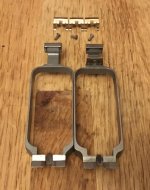Just got my 1013 up and running. Fired it today and it didn't miss a beat. Came home to go ahead and convert another mag.
Took the gun apart to clean and found a piece of the trigger play spring that fell out. The entire top of spring is gone. Will that spring being broken cause any problems? Is it possible I caused it to break? I thought I had sent this gun to the mothership about 2 years ago and was thinking they had replaced it.
I have a 21lb spring in it, but it was still throwing the spent brass about 15'-20'. But every 10mm I have ever owned tossed it a long way. So I am thinking that is normal.
Thanks,
Rosewood
Took the gun apart to clean and found a piece of the trigger play spring that fell out. The entire top of spring is gone. Will that spring being broken cause any problems? Is it possible I caused it to break? I thought I had sent this gun to the mothership about 2 years ago and was thinking they had replaced it.
I have a 21lb spring in it, but it was still throwing the spent brass about 15'-20'. But every 10mm I have ever owned tossed it a long way. So I am thinking that is normal.
Thanks,
Rosewood
Attachments
Last edited:










